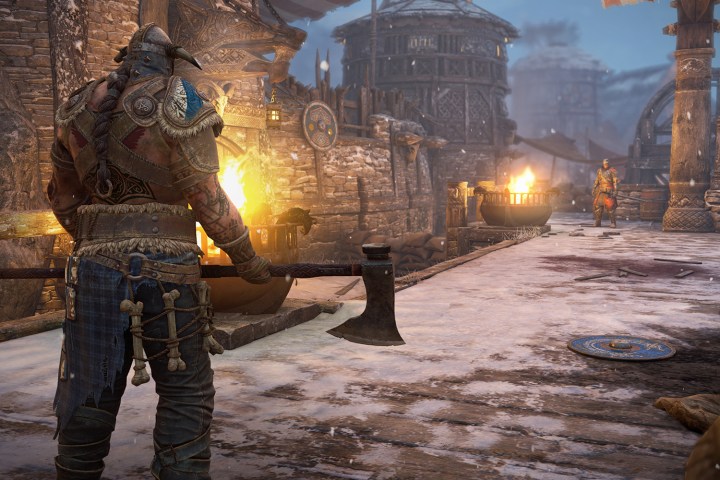
“Duels” is perhaps the most enthralling game mode in Ubisoft’s medieval brawling simulator, For Honor . It exclusively shows off the game’s innovative combat system — aka, “The Art of Battle” — and gives players the opportunity to really test their prowess without the risk of getting ganged-up on. Let’s say you already know how the game’s rock-paper-scissors combat works, but you’re struggling to win matches on a consistent basis. These nine dueling tips will help keep you on your feet for the long haul.
Choosing a Hero
Unlike the other multiplayer variants — Deathmatch, Dominion, and Brawl — you should always pick a hero that you know well. It’s just you versus your opponent in a battle to the death, and the last thing you want is to be fumbling along with a hero you are less than familiar with. That being said, if you’re adept with Warden, you should be fine switching to Raider or Kensei, as all three are in the Vanguard class. This logic applies to the respective Heavy, Assassin, and Hybrid classes as well.
Let your opponent make the first move
When the first round begins, you may feel the urge to rush toward your opponent and lunge for the first blow, but we suggest maintaining your distance. Let your opponent take the first shot, at least in the first round. This allows you can get a sense of their go-to tendencies. The ability to predict your opponent’s moves is a great trait to possess — one that you will likely develop over time — but it’s helpful to get an immediate feel for who you’re up against. After all, you can lose two rounds and still come away victorious. Don’t show your hand to early, as patience is often rewarded with those gruesome, end-of-round executions.

Stand your Ground
For Honor is all about your battle stance. Ideally, the majority of each duel should be spent in guard mode, fielding off enemy attacks and delivering ones of your own when you have an opening. When you’re in the thick of a testing duel and your health is in the red, you may be tempted to start flailing away to make up for being behind. In most cases, this would be the wrong decision, though. Stick to the framework as it was designed. Even when things look dire, hold that sword right, left, or above your head, and keep calm.
Proximity
Right up there with maintaining your stance, balancing the correct distance between you and your opponent is paramount. Preferably, you’d like to be just far enough away to land a heavy attack. If your opponent steps backward, step forward to counteract the created distant between the two of you. If your opponent dodges left, dodge with them. Mirroring your opponent’s moves to maintain optimal distance puts you in the best position to get the most out of your full moveset.
Keep note of your surroundings
While your main focus should always be on your opponent’s actions, don’t forget to take note of your surroundings. If your opponent inches toward a wall, pummel them into it with a throw. If you’re near a set of stairs, go up them to earn the advantage granted by higher ground. And if your opponent nears a ledge, don’t hesitate to try and knock them off with a push. Conversely, when you find yourself cornered near a wall or looking up at your opponent, remedy it by regrouping, and, if possible, force them to come at you and guide them into a disadvantageous position.

Diversify your core moves
Your five principle moves — blocking, parrying, light/heavy attacks, guard breaks, and dodging — should be used strategically throughout battle. It’s great to string together a series of blocks, but switch it up by throwing in a parry. Similarly, it may be tempting to go for heavy blow after heavy blow, but you’re better off delivering at least twice as many light attacks as heavy attacks. As for guard breaks and dodging, combining these two tactics often works. Dodge left or right, and then quickly go in for the guard break when your opponent tries to reposition themselves. The less predictable you are, the more trouble you will be to defend against. By being a wild card in this rock-paper-scissors duel to the grave, you will generate more openings for yourself that lead to victory.
Employ your special movesets
A sound grasp of your core moves may be enough to defeat a large percentage of your opponents, but when you run into an equally attentive dueler, shaking things up with special moves and chained combos will help give you the edge needed to be the deadliest warrior. Each hero has at least six special moves, and working a few of these into your dueling diet will put you a cut above the rest. Be cautious, though, and use them sparingly. Otherwise you risk tunnel vision, exposing yourself and shirking your fundamentals in the name of pulling off fancy tricks.
Know your enemy
Not all heroes perform in the same fashion, and even if you consistently choose a hero you are comfortable with, you may still have to refine your style of play depending on which hero you are facing. A good way to learn about other characters is to watch the tutorial videos that show off their unique talents. If you stick to your technique, there’s no reason why you cannot beat a hero that isn’t technically a good matchup against your own, but keeping your opponent’s strengths and weaknesses in mind will definitely make things easier for you.

Stamina, stamina, stamina
This cannot be stressed enough: If you get too swing-happy or rely too much on more laborious special moves, your hero is going to need a breather, and you can’t have that in the middle of a heated battle. A fully depleted stamina bar makes you an easy target. If you find your stamina at critical levels, exit guard mode and retreat. You could use dodge to fling backward out of reach, but if your stamina is already dangerously low, that might send you over the edge and turn your screen black and white, an ominous foreshadowing of your likely defeat.
Editors' Recommendations
- How to hack in Fallout 4
- The most common PSVR 2 problems and how to fix them
- PlayStation Spring Sale: best deals, how long is the sale, and more
- How long is Dragon’s Dogma 2?
- All companions in Baldur’s Gate 3 and how to get them


